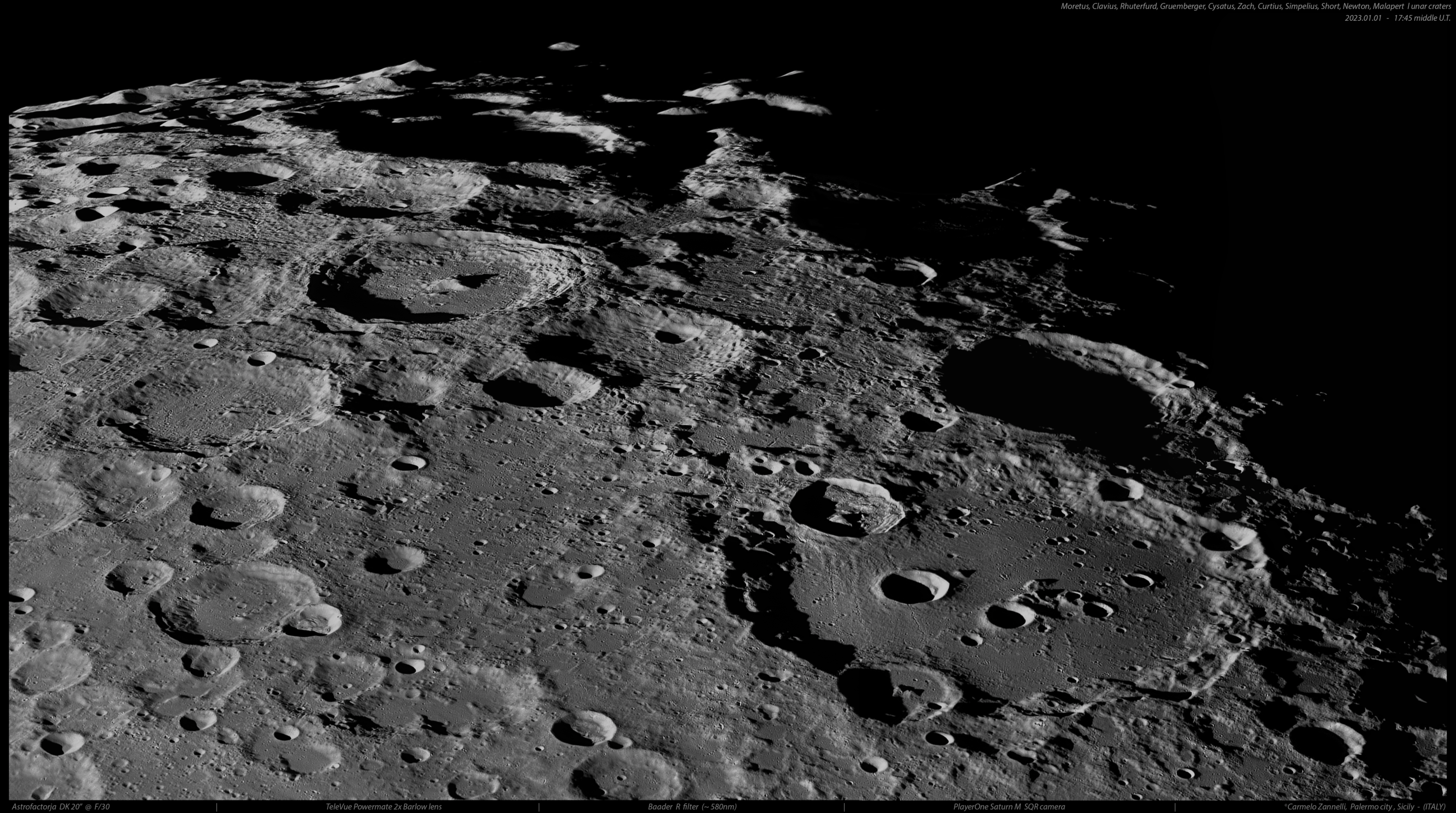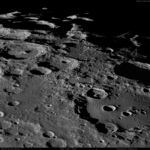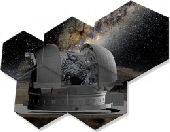Italiano (for English please read below):
Ecco un’altra ripresa lunare della fortunata serie del primo gennaio 2023 scorso, in buone condizioni di seeing.
La zone è quella che, lungo il terminatore della Luna di 9 giorni (quindi dopo il primo quarto), porta al Polo Sud lunare dove la NASA sta studiando la possibilità di scegliere uno dei siti all’interno di alcuni crateri come base lunare permanente, a causa della presenza di depositi di ghiaccio sul fondo di alcuni di essi dove la luce solare non giunge mai.
I crateri prominenti, in questa immagine, sono “Clavius” (231 km. di diametro) su tutti, ed il cratere “Moretus” (114,5 km.) col suo bellissimo picco centrale, leggermente sulla sinistra in alto.
Clavius è il terzo cratere, in ordine di grandezza, tra quelli presenti nell’emisfero lunare rivolto verso la Terra e si trova sugli altopiani irregolari più a sud del bellissimo cratere Tycho, (non visibile in questa mia ripresa, poiché fuori inquadratura). Il cratere è dedicato al matematico e astronomo tedesco Cristoforo Clavio, noto anche con il nome latinizzato di “Clavius”.
Recentemente (il 26 ottobre 2020) la NASA ha annunciato per la prima volta il rilevamento di acqua molecolare all’interno del cratere Clavius, scoperta che scaturisce da una ricerca dell’Università del Colorado a Boulder, basata sulle immagini della Luna scattate per la prima volta dall’osservatorio SOFIA (Stratospheric Observatory for Infrared Astronomy) in combinazione con le misurazioni della temperatura prese dal LRO (Lunar Reconnaissance Orbiter). Questo importantissimo ritrovamento permette di ampliare i siti di ricerca, in precedenza ritenuti strettamente correlati alle zone polari lunari ed è una buona notizia in ottica futura, in particolare per le future missioni lunari “Artemis”.
A causa della posizione, vicina al margine meridionale, Clavius appare come se fosse oblungo ed è una delle formazioni più antiche ancora visibili sul satellite dato che si è probabilmente formato durante il periodo Nettariano, circa 4 miliardi di anni or sono, in seguito ad un grande impatto asteroidale.
L’interno del cratere è costituito da un pianoro convesso, marcato da alcuni crateri tra i quali la formazione più interessante è la catena che inizia a sud con Rutherfurd e prosegue ad arco, in senso orario, con crateri via via più piccoli, indicati come Clavius D, C, N, J, e JA. Al centro, tra i crateri Clavius C ed N, si possono osservare i vaghi resti di un antichissimo picco centrale. La relativa uniformità della zona centrale e la piccolezza del picco centrale sembrano indicare che questa superficie si sia formata in un periodo successivo all’impatto originale.
Si possono osservare numerosi altri notevoli crateri nelle vicinanze: a ovest Scheiner (visibile solo mezzo bordo del cratere, ancora quasi totalmente in ombra), a sud-ovest Blancanus (con i soli bordi illuminati, il resto ancora in ombra), ancora più a sud e verso il terminatore in ombra, i crateri Klaproth, Casatus e Newton (nell’immagine ancor più sopra il cratere Moretus, verso l’estremità sud lunare). Il cratere Rutherfurd si trova interamente all’interno del bordo di Clavius, mentre Porter si sovrappone al margine nord-est.
L’altro cratere prominente, in questa immagine, è “Moretus” un grande cratere lunare di 114,45 km situato nella parte più sud-occidentale lunare.
Recentemente, grazie a nuovi dati raccolti da un team di ricercatori del Goddard Space Flight Center, sono state trovate molecole d’acqua anche nella zona del cratere Moretus e per questo sarà possibile studiarlo anche da Terra senza bisogno di orbiter lunari, per rilevarne depositi per le future missioni lunari.
Grazie per la Vs. attenzione e … ad maiora semper!
Dettagli Tecnici:
Telescopio Astrofaktorja DK20″ @ ~ F/27 – Player One Saturn M camera – Televue Powermate Barlow 2x – Baader R filter – Seeing ~ 7/10 (max.) in R band – sito: Palermo @ my personal Observatory.
******************************************************************************************************************
English:
Here is another lunar shot of the lucky series of last January 1, 2023, under good seeing conditions (about 7/10 in the Red channel).
The zone is that which, along the 9-day terminator of the Moon (therefore after the first quarter), leads to the lunar South Pole where the NASA is studying the possibility of choosing one of the sites inside some craters, as a permanent lunar base due to the presence of ice deposits on the bottom of some of them where sunlight never reaches.
The prominent craters, in this image , are “Clavius” (231 km. in diameter) above all, and the crater “Moretus” (114.5 km.) with its beautiful central peak, slightly on the upper left. Clavius is the third crater, in order of size , among those present in the lunar hemisphere facing the Earth and is located on the irregular plateaus further south of the beautiful crater Tycho, (not visible in my shot, since it is out of frame). The crater is dedicated to the German mathematician and astronomer Christopher Clavius, also known by the Latinized name “Clavius”.
Recently (October 26, 2020) NASA announced for the first time the detection of molecular water inside the Clavius crater, discovery resulting from research by the University of Colorado in Boulder, based on images of the Moon taken for the first time by the SOFIA (Stratospheric Observatory for Infrared Astronomy) observatory in combination with temperature measurements taken by the LRO (Lunar Reconnaissance Orbiter) .
This very important finding allows to expand the research sites, previously considered closely related to the lunar polar areas and is good news for the future, in particular for future lunar “Artemis” missions. Due to the position, close to the southern margin, Clavius appears as if it were oblong and is one of the oldest formations still visible on the satellite since it was probably formed during the Nectarian period, about 4 billion years ago, following a large asteroid impact.
The interior of the crater is consisting of a convex plateau, marked by some craters among which the most interesting formation is the chain that begins in the south with Rutherfurd and continues in an arc, clockwise, with gradually smaller craters, indicated as Clavius D, C, N , J, and JA. In the centre, between the Clavius C and N craters, the vague remains of an ancient central peak can be observed. The relative uniformity of the central area and the smallness of the central peak seem to indicate that this surface was formed after the original impact.
Several other notable craters can be observed in the vicinity: in the west Scheiner (visible only half the crater rim, still almost totally in the shade), to the south-west Blancanus (with only the edges illuminated, the rest still in the shade), further south and towards the terminator in the shade, the craters Klaproth, Casatus and Newton (in the image even more above Moretus crater, towards the lunar south end). Rutherfurd crater is located entirely within the rim of Clavius, while Porter overlaps the northeast rim.
The other prominent crater in this image is “Moretus”, a large lunar crater measuring 114.45 km located in the most southwestern part of the moon.
Recently, thanks to new data collected by a team of researchers from the Goddard Space Flight Center, water molecules have also been found in the area of the Moretus crater and for this reason it will also be possible to study it from Earth without the need for lunar orbiters, to detect iced water deposits for future lunar missions.
Thanks for your attention and … ad maiora semper !
Technical Details:
Astrofaktorja DK20″ telescope @ ~ F/27 – Player One Saturn M camera – Televue Powermate Barlow 2x – Baader R filter – Seeing ~ 7/10 (max.) in R band – site: Palermo @ my personal Observatory.


